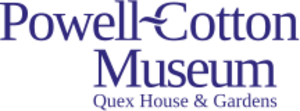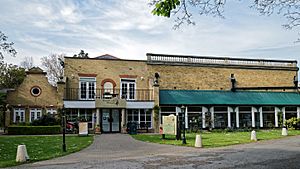Powell-Cotton Museum facts for kids
 |
|

Front of the museum in May 2016
|
|
| Lua error in Module:Location_map at line 420: attempt to index field 'wikibase' (a nil value). | |
| Established | 1896 |
|---|---|
| Location | Birchington, Kent, CT7 United Kingdom |
| Type | Natural history and anthropology museum |
The Powell-Cotton Museum is a super interesting place located in Quex Park in Birchington, England. It's filled with amazing collections gathered by a famous explorer and hunter named Percy Powell-Cotton. His two daughters, Antoinette and Diana Powell-Cotton, also loved collecting things, and their treasures are here too!
This museum is connected to Quex House and has nine different rooms, called galleries. These galleries show off a huge collection of large animals and many cool objects. These objects tell stories about the cultures and traditions of the places Percy Powell-Cotton visited on his adventures.
Contents
How the Museum Started
The museum began in a small way in 1896. Percy Powell-Cotton started with just one room for his collections. He then decided to build a special building, called a pavilion, in the gardens of Quex House. His brother, Gerald, helped to make sure it was built right.
Percy also got help from Rowland Ward, a very skilled person who prepared animals for display. This process is called taxidermy. Percy, who used to be a soldier, brought back thousands of items from his trips. These included animals he hunted and other things he collected.
After Percy Powell-Cotton passed away in 1940, his son Christopher added even more galleries. These new rooms held the family's other collections. These included ancient tools and objects (from Antoinette Powell-Cotton), items from different cultures (from Diana Powell-Cotton), beautiful pottery, and old weapons.
Exploring the Museum Galleries
The Powell-Cotton Museum has many galleries, each with unique displays. Let's take a look at some of the most exciting ones!
Gallery 1: Amazing Animals
This gallery, opened in 1947, has three large displays that show animals in their natural homes. One of the most famous displays here is a huge collection of African monkeys and apes. It's so big and has so many different kinds of primates that it's one of the best in Europe! In total, this gallery has almost 2,000 animal specimens.
Gallery 2: The Original Pavilion
This room is the very first pavilion that Percy built in 1896. It's packed with many mounted heads of large animals from Africa and Asia. On the other side of the room, you'll find another big display showing animals from the Himalayas. Percy had to brave very cold weather to find these animals with their thick winter coats. This display is known as the oldest, unchanged, room-sized natural history diorama in the world.
Gallery 3: Lion vs. Buffalo
Gallery 3, opened in 1908, has a dramatic display right in the middle of the room. It shows a fight between a lion and a buffalo. The lion in the display is the actual animal that attacked Percy Powell-Cotton in 1906! Luckily, he survived. The buffalo is a special kind of animal that was named after him. This gallery also has another large display showing a scene from Africa, where animals gather to drink at a waterhole.
Gallery 4: Films and Stories
This gallery, added in 1955, focuses on media. It includes old film footage shot by Percy's daughters, Diana and Antoinette. These films show what a typical day was like for a Kwanyama family in Africa. The museum has a large collection of films made by Percy and his daughters, showing their travels and discoveries.
Gallery 5 & 6: Cultures and Crafts
Galleries 5 and 6, both opened in 1970, are all about the cultures of Africa. They display many handmade items like stools, combs, and things people wore for dress and decoration. Gallery 6 also shows models of a farmstead from the Kuanyama people of Angola. You can also see items they used for fun and carefully made weapons. Many old photographs in these galleries show how these items were used in daily life.
Gallery 7: Ancient History and Trade
Opened in 1966, Gallery 7 explores archaeology. It displays tools from the Stone Age (Paleolithic period) found in east Kent. You can also see early pottery from the New Stone Age (Neolithic period). This gallery also tells the story of the Cotton family's involvement in the China trade during the 1700s.
Gallery 8: Chinese Porcelain
Gallery 8, added in 1973, features a beautiful collection of Chinese imperial porcelain. These delicate items date from 1662 to 1908. Percy Powell-Cotton bought most of this collection in 1910.
Passage Gallery: Weapons Through Time
The Passage Gallery, from 1955, shows off many different firearms and cutting weapons. These come from places like Malaysia, India, and Indonesia. There's also a display that shows how military firearms have changed over time.
Learning and Research
The museum is a great place for learning! It welcomes school groups, families, and even university students. There's a special conference room for learning and research in science and social studies. If you arrange it beforehand, staff can give guided tours. The museum's main goal is to be "in trust for the enjoyment of visitors and the benefit of students." This keeps Percy Powell-Cotton's legacy alive.
Museum's Reputation
The Powell-Cotton Museum is well-known for its wide range of animals and cultural objects. It's an important place for scientists and researchers who study nature and human societies. They can even arrange to study the collections. The museum often works with The Natural History Museum, London and attracts students from all over the world.
The museum and its beautiful grounds are also used for special events like company meetings and weddings.
How to Get There
The Powell-Cotton Museum is located inside Quex Park in Birchington, Kent. It's about 12 miles from the city of Canterbury. The museum offers free parking for cars and buses. All areas of the museum and gardens are accessible for people with disabilities.
The closest train station is Birchington-on-Sea. It's about a 20-minute walk from the park and takes about 1 hour and 40 minutes to get there from London Victoria. Another nearby station is Margate, which is about 1 hour and 20 minutes from London St Pancras by high-speed train. If you prefer the bus, the number 8 Thanet bus stops at Birchington Square, which is about a half-mile walk from the park.
Images for kids



